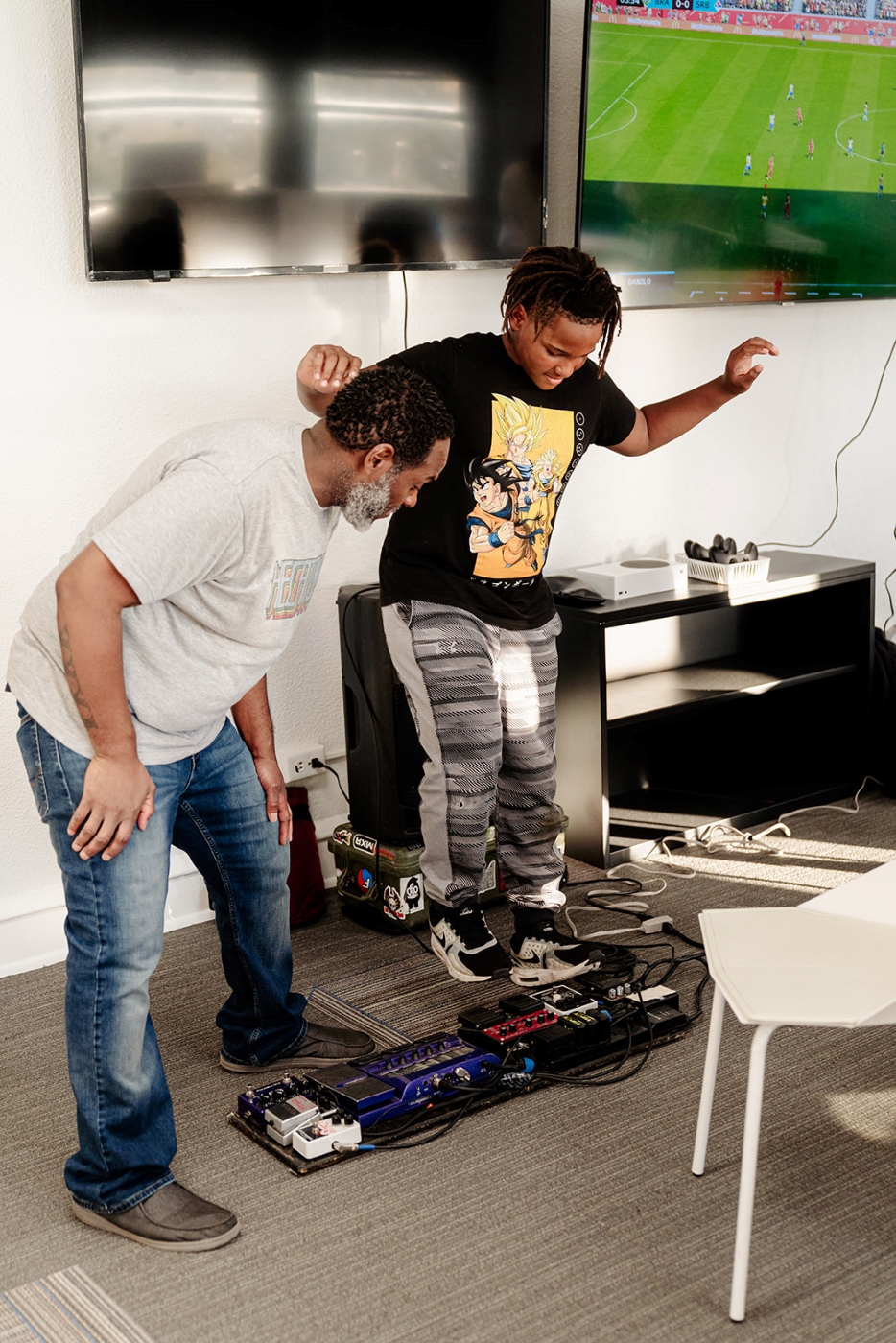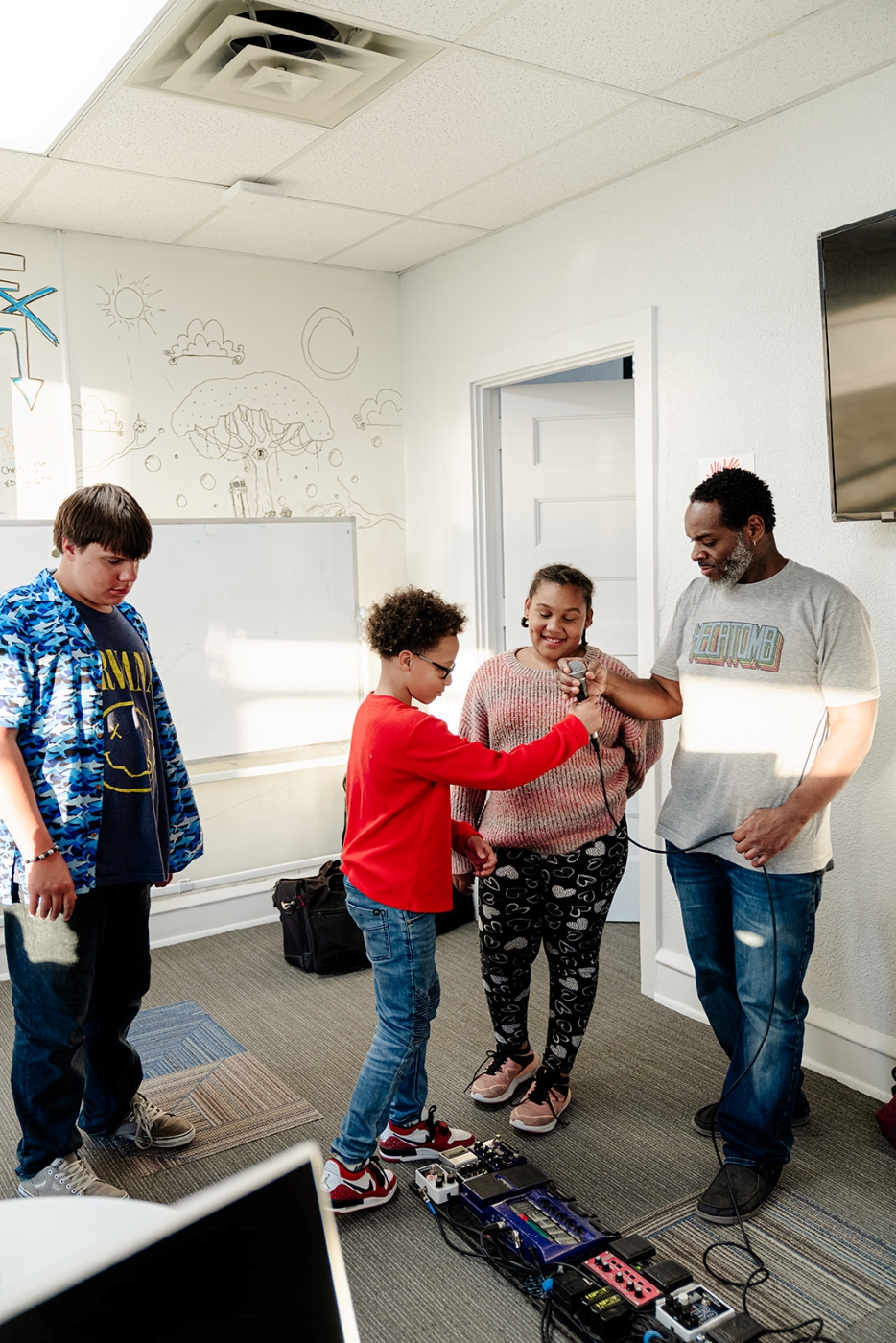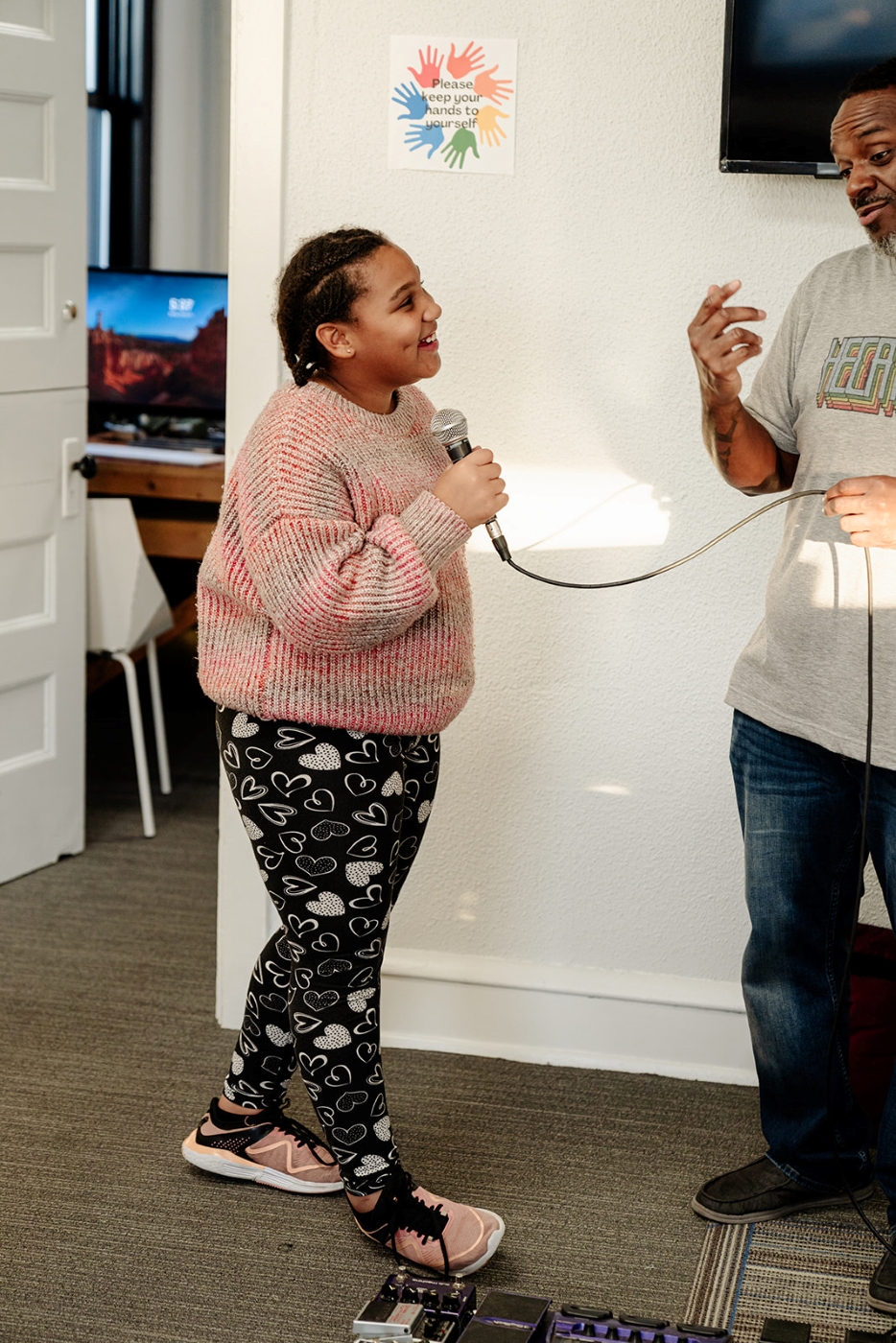MacPhail and Smart North – A Powerful Partnership

On a weekday afternoon last month, Terrell “Carnage” Woods walked into a community tech hub for youth in downtown Minneapolis. A beatboxing instructor at MacPhail Center for Music, Terrell had his favorite music-making tools with him—digital and analog foot pedals.
A group of young teens gathered around him as he demonstrated his method of creating music. He showed them how he could vibrate his lips to make a low bass note, then turn on his bass octave effects pedal to transform the note. Now it sounded like a low bass guitar. Then he showed the teens how he could manipulate that sound, layering it over other sounds, on a computer with a DAW (digital audio workstation). Finally, he let them try it for themselves.
“It was easily the first time they got to do that,” says Terrell. “They were just excited. It got to the point where I was like, ‘If you’re liking this, I can tell you where you can get these pedals.’ And they were looking at their [tech hub] instructors like, ‘Really?!’ I said, ‘I’ll show you how to work them, too. I’ll come in here and do an extra tutorial.’”
Terrell was at the hub as part of a partnership between MacPhail’s Electronic Music and Recording Arts (EMRA) department and Smart North, a non-profit dedicated to advancing digital equity. Smart North has created two tech hubs for youth—one in South Minneapolis (inside the Sabathani Community Center in George Floyd Square) and one in Dear River. And MacPhail is helping to build their music program.
“We want to give kids the baseline exposure and opportunity to experience the tech economy,”
Petra King, Smart North Community Tech Hub Manager



Meeting kids where they’re at
Smart North was created to help tackle Minneapolis’ problem of digital inequity. Minnesota is one of the most prosperous states in America, with above-average per capita incomes and the largest concentration of Fortune 500 companies. But the state ranks at the bottom in tech education. And there’s a wide gap when it comes to accessing digital resources and learning.
Smart North’s founders recognize that for some people, tech knowledge can offer a way to break a generational cycle of poverty and oppression. So, through its tech hubs, Smart North serves traditionally overlooked communities with technological and workforce training. It offers them access not only to tech resources—like touch screen computers, whiteboard walls, 3D printers, a PS5 gaming lounge, drawing tablets, and computer software—but also to experts who can show them how to use these tools.
“We want to give kids the baseline exposure and opportunity to experience the tech economy,” says Smart North’s community tech hub manager, Petra King. “And we’re meeting the kids where they’re at, getting them into it through lenses that they enjoy—like music.”
To that end, Smart North’s South Minneapolis hub is equipped with a music and recording studio, and a producer visits regularly. But King and her colleagues are always working to bring in tech industry leaders to coach young people in using the digital equipment they provide. Smart North needed some experts in how to use their full range of musical technology.
“They didn’t really have a sense of how to take it to the next level, and that’s EMRA’s expertise throughout our whole faculty,” says EMRA’s program director, Michael Cain. “We’ve already been doing this with partnerships with middle schools and high schools for a while, teaching digital music production, DJ’ing, songwriting, and a wide range of skills.”
The format is that four EMRA teachers visit the hub over the course of eight weeks, working directly with students and helping to facilitate student-generated music.
“The teachers each have different expertise and slightly different skill sets so they can provide a real comprehensive overview of different aspects of music creation,” he says. “Some focus more on songwriting. Some would be more on the digital mixing, mastering, and the recording side. One will be on the DJ side. We want to expose the kids who are attending to a wide range of skills and expertise.”
“We don’t sit down and say, ‘We’re gonna talk at you,’” Michael explains. “We come in and say, ‘Here’s who we are. What are you interested in? What have you been working on? How can we help?’”
“The teachers each have different expertise and slightly different skill sets so they can provide a real comprehensive overview of different aspects of music creation,”
Michael Cain, MacPhail Electronic Music Recording Arts Director

Another layer of tech exposure
EMRA’s studio coordinator Isaac Rohr was one of the first teachers to visit the hub. At MacPhail, he teaches Electronic Music, Music Production, and Recording Arts. At Smart North, he focused on introducing the kids to music production and making beats in Band Lab, which is a web-based DAW.
He worked with a few teens who were already budding rappers but wanted to learn how to mix their vocals better with their beats. Another teen, a singer, was doing covers in the studio, and Isaac taught her how to record more professionally.
While all the kids were at an early stage of learning, most had an understanding of the baseline process.
“Kids are learning from the internet and social media,” he says. “They are being exposed that way because these tools are so accessible right now.”
He makes a point of using those available tools as he teaches. For example, his use of software applications like Band Lab and Garage Band is strategic—because they’re free.
“Garage Band is already on an iPhone when you get it,” Isaac says. “I love the idea of being able to expose kids to something, and they can use it when they leave.”
Growing creatively with music
Some of the young people were interested in creating music for movies and video games. That comes under the purview of Barbara Cohen, MacPhail’s songwriting, film composition, production, and vocal coaching instructor.
Cohen calls her curriculum “an easy on-ramp into starting to think like a film or game composer.”
She began by asking the students to look for a digital image that’s interesting to them. “It can be anything—something from nature, a film poster, a still from a game, or an animation.”
From this single image, she prompted them to create a world. “What’s the atmosphere like? What do you eat? What are the goals? Are there scary things? Are there beautiful things?”
Then Cohen guided them to think about what the soundtrack would feel like. “Is it a big heroic feeling, or is it a slow ambient kind of thing? What’s the vibe?”
Finally, she showed them how to work with a DAW (here it was Band Lab software) to create the emotion they’re trying to capture.
“They all got into it, and then they shared what their game or their film was with each other,” she says. “It was pretty revealing. Sometimes they were goofy, and sometimes they were pretty deep and intense.”
The overall effect is twofold. “The idea is to give them an opportunity to express themselves through music and help them understand certain technologies,” she says. “It was a lot of fun. The students are a lively bunch.”
The idea is to give them an opportunity to express themselves through music and help them understand certain technologies…it was a lot of fun. The students are a lively bunch.”
Barbara Cohen, MacPhail Electronic Music Recording Arts Instructor

Using what you have
Terrell brought his own unique contributions to Smart North. “I went in there with my method of connecting musically with kids, which is not with the traditional software and computer programs,” he says.
Terrell’s philosophy is that there are myriad ways to make music, and you can mine great depths of creativity with your voice and some foot pedals.
“We are all doing what we can do the best way we can with what we have,” he says. “You have your body and if you never learned how to play an instrument and you love music, you have to figure out a way to use your body to make the musical sounds of instruments that you don’t have access to playing.”
As an instructor, Terrell found the teens’ response extremely gratifying. He recalls that at one point, he’d hardly finished his demonstration when several kids were keen to try it for themselves.
“One kid was trying to take the mic out of my hand,” Terrell says, laughing. “He was like, ‘I’m ready!’ There was some really good excitement with a couple of the youth wanting to jump right in.”
He notes that in the rap and hip-hop communities, artists aren’t always generous with their ideas and techniques. There’s a strong focus on originality, which can prevent people from sharing.
“I take the need to be original seriously,” Terrell says. “But I also like to share what I’m doing with other people so they can find their own power and their own voice.”
When it comes to creating art, Terrell sees himself less as a teacher and more as a mentor and coach—someone who gives young people the tools they need to create on their own terms.
“I’m not trying to tell kids how to do what I do,” he says. “I’m trying to show them what I do with what I have and help them find their own unique voices using some of the same methods I’m using.”
